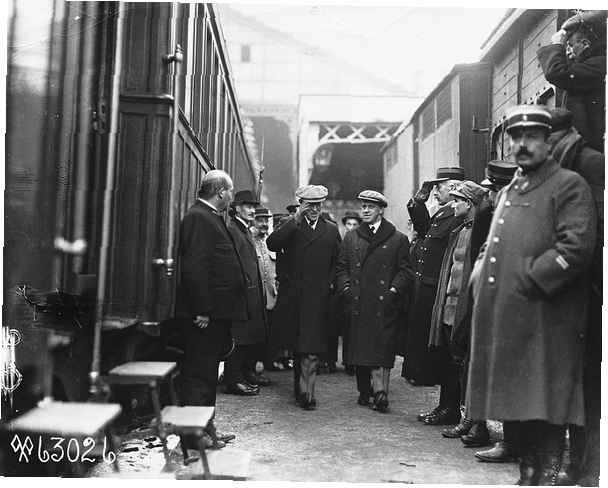Committee on Public Information: When the U.S. Used ‘Fake News’ to Sell Americans on World War I
Published: 15 January 2024
By Caryn E. Neumann
via the Free Speech Center at Middle Tennessee State University web site

george creel with Wilson 1919
President Woodrow Wilson and George Creel of the Committee on Public Information (center) taking a stroll during a station stop on the train journey to Rome in 1919 after World War I.
The Committee on Public Information (CPI), also known as the Creel Committee after its chairman, George Creel, served as the first large-scale propaganda agency of the U.S. government.

The Committee on Public Information produced war propaganda meant to build support for World War I and demonize the German military. One of the committee’s more vivid posters depicts a German as a gorilla with a club (Image via Library of Congress, public domain)
CPI established to mobilize public opinion behind World War I
President Woodrow Wilson established the committee in April 1917 through Executive Order 2594 in response to the U.S. entry into World War I in an attempt to mobilize public opinion behind the war effort with every available form of mass communication.
One section of CPI coordinated work abroad, and another section oversaw work on the home front. The domestic section consisted of bureaus targeting a wide variety of groups, including laborers, women, industrialists, farmers, and immigrants. In delivering its message to such groups, the CPI sought to make every American a participant in the war effort.
Creel, a former journalist, particularly targeted newspapers. He later estimated that the news division placed material in 20,000 newspaper columns each week during the war. A separate newspaper division monitored the hundreds of foreign-language publications in the United States.
Beginning in May 1917 and running through March 1919, the CPI published Official Bulletin, a newspaper distributed free to public officials, newspapers, post offices, and other agencies. It carried statements from the government and had a circulation of about 115,000.
CPI built intellectual justification for U.S. war involvement
In the effort to build an intellectual justification for U.S. involvement in the war, Creel appointed University of Minnesota history professor Guy Stanton Ford to head the division of civic and educational publications.
Ford’s section published more than 100 titles that defined American ideals, indicted German militarism, promoted the expansion of the president’s power in foreign relations, told Americans what they could do to speed victory, and endorsed censorship.
Visual images further helped to mobilize support for the war. The division of pictorial publicity joined with the division of advertising to create some of the war’s most vivid images in posters designed to demonize the German military. Some of the more infamous posters portrayed a German gorilla with a club labeled kultur and a green-eyed, blue-skinned German soldier with bloody fingers.
CPI’s war propaganda later viewed as dissent suppression
Not every American made the distinction between Germans overseas and German-born Americans in the United States. In addition, the government linked any opposition to the war effort, whether by pacifists or communists, to treason. It trampled First Amendment rights, largely because of the success of the CPI in instilling fear through war propaganda. The CPI often blurred Wilson’s political goals with the national interest.
Read the entire article on the Free Speech Center web site here:
External Web Site Notice: This page contains information directly presented from an external source. The terms and conditions of this page may not be the same as those of this website. Click here to read the full disclaimer notice for external web sites. Thank you.



